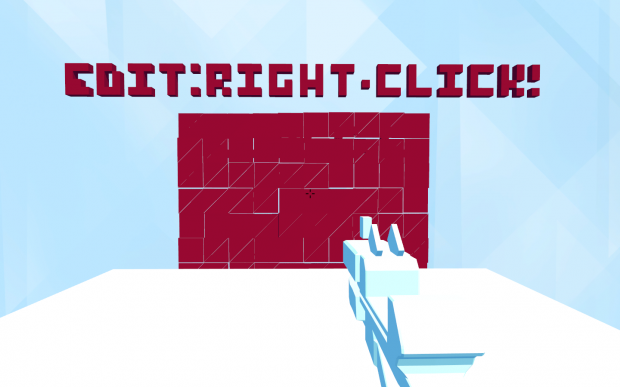Indie Rock: Glitchspace
- Updated: 23rd Apr, 2014

My pitch for this year’s “theme”, now that we’re months past The Fiscal Year Of Luigi and are desperately clawing at anything that can lend our existence any meaning in our frozen-over hellscape, is clearly “games where the gameplay is in letting you have a cheeky mess around with the existing code”. I’ll admit it’s not initially as catchy and I’ve got my work cut out getting this to resonate with the key gamer demographics, but wait until you see the graphic design treatment I’m working on.
Quadrilateral Cowboy is on the way. Hack ‘n’ Slash was properly announced. We had a look at Changetype two weeks ago. That’s enough of a connecting thread to go on. That’s three things. It’s more than a coincidence. I’m ready to close the book on this case, chief.
I’m playing Glitchspace. It’s a platformer in the first person perspective, which is a pitch that sets off some alarm bells, so thankfully that’s not all that the video game is. It’s also another one of the things I’ve just been describing.
There are Red Platforms which float around in an abstract videogamey world. They can be edited with an Editing Gun, which you’ve got for reasons unnecessary. You need to change the properties of these platforms in order to create a path through a level. They’ll be too small or lack collision or a number of other different problems.
To begin, their variables are locked and you’re only able to pick from a few predetermined suggestions of alteration. Hitting the right mouse button brings up a menu with a few connected blocks that all apply certain locked attributes about the Platform. Let’s say there are a few things that are already true of this: It’s set to exist. It’s set to have collision. These are all locked in place. There’s a box set to how long it can be made, but you can attach another block with a number in it to this block. Once that’s done the platform immediately stretches out and you’ve created a bridge long enough to get you from one point to another.
There’s a good puzzle and a great bit of teaching design which takes into account the idea that you might fail, but then potentially learn another lesson instead. And that’s my fucking jam. [There’s nothing that a hundred men or more could ever do – Ed.]
One of the platforms is programmed to not have any collision, and programming it so that the collision value is True is possible, but slightly more convoluted a process than you’ve already been introduced to. You can absolutely solve it first try, but you might not.
 The only way that you can test you’re correct is to jump on the platform and see if it will enable you to stand on it. If you can’t, you’ll pass through the platform entirely and end up in a hole in the bottom of a pit, standing on another red platform which has collision.
The only way that you can test you’re correct is to jump on the platform and see if it will enable you to stand on it. If you can’t, you’ll pass through the platform entirely and end up in a hole in the bottom of a pit, standing on another red platform which has collision.
Normally when you fall off the world the game just resets you, but here you’re introduced to the idea of making a platform apply force against anything that touches it. You can add a couple numbers and suddenly the platform is bouncy! You made a bouncy trampoline in the video game! That’s all you! No one told you how, but you figured it out!
Y’know what I’d like, near the end of the game? Sillier things. Editing the platforms so that their textures are different. Solutions which have nothing to do with actually finishing the level, just making wild shit happen because you’re able to. Maybe even discovering entirely new ways to complete the same task but with wildly different approaches.
This is a wonderful video game for anyone totally into game design, but without much of a background in actually programming video games themselves. It’s in Alpha right now but it is already worth the price of admission.

Follow Us!